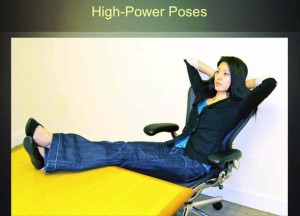Do you know how to manage your energy in order to command a room? Does the idea of doing a presentation make you want to run and hide? What does research say about the ability to increase our presence? I’ve spent almost 20 years of my life thinking about this very topic. First, I worked as a Yale trained actor and producer in New York City and then as a leadership development consultant and coach. What I have noticed is that there are a number of myths associated with presence.
The first myth is that you either have it or you don’t. If this were true there wouldn’t be any drama schools, no need for weeks of rehearsals before opening night and nor cottage industry for selling classes to actors. There are tangible techniques that you can use to control your anxiety and increase your influence whether you have a formal presentation or are just running a meeting. I’ll look at the external aspects of presence, the internal aspects of presence, managing anxiety and accessing flow.
When you get up in front of a room…what do you want? Many people who are presenting have one goal – to get off as fast as possible. But our intention has a big impact on our presence and on our audience.
Masaru Himoto is a scientist who studied the molecular structure of water. When subjects send distilled water positive thoughts like love, appreciation, happiness, and truth. As a result the water turned into delicate crystalline shapes.
When water was sent a negative message like hatred and hostility, the water turned into chaotic fragmented structures. Water makes up 60% of human body and 70% of human brain. The energy and attention we send to ourselves and others has an enormous affect on our well being and our presence. You must be attuned to your own true self. If you are putting on persona or disguise an audience will know. We know from recent psychology research that emotions are, in fact, contagious.
In the theater an actor with Stanislavsky training will choose an action verb – an infinitive – to be their ‘objective’ for the entire play. Every action you take falls under that one verb. The lead role in the movie Stand and Deliver might have an objective – to inspire. Junah, the Matt Damon role in the dreadful golf movie The Legend of Baggar Vance might have an objective – to find my true swing. Sandra Bullock’s character in The Blind Side might have an objective – to mentor. So when you are presenting or leading your next meeting – what is your objective? To inspire? To entertain? To enliven?
Managing Emotions
Much has been written in the psychological literature (from cognitive behavioral therapy to Peter Salovey’s work on EQ) about emotions. Managing emotions is one of those aspects of external presence you can control. One study had half of the participants place a pencil in between their teeth (inducing a smile) and the other half placed a pencil in between their eyebrows (inducing a frown). The results showed that people who were induced with a smile were happier than the control group. And participants who were induced with a frown were less happy than the control group. People always ask me if you can ‘fake it til you make it’. I think this work and Amy Cuddy’s work displays evidence that you can.
Power Poses
Amy Cuddy is a social science researcher from Harvard Business School. Her famous YouTube on power poses has been viewed over three million times. In it she discusses how she noticed that certain people in her classes were asking questions and certain students (usually the females and non-white males) were not speaking up. She also noticed that they had very different postures in class. This led her to track the level of testosterone (power/strength hormone) and cortisol (stress hormone) of subjects who were in different poses. When they were in poses hunched over an iPhone (which is what you might be doing before a job interview, for instance) they had high levels of cortisol, which made them perform more poorly in the interview. When she had subjects spend just 2 minutes before their interview in one of a few ‘power poses’ (i.e. feet on a desk, hands on hips, arms out wide in a ‘Y’) their cortisol dropped and their testosterone shot up. They performed much better in their interviews. She doesn’t recommending striking the pose in the middle of the interview, however.
Keep Breathing
While there are any number of aspects of physical presence I get asked about on a regular basis (i.e. “What do I do with my hands?”) there is one that is the North Star. If you can get your breathing correct it can cure a multitude of sins.
As you’re reading this, place your left hand on your chest and your right hand on your lower belly. Take a few deep breaths in through your nose and out through your mouth. (By the way, this is the most efficient way to breathe. Nostril breathing warms and filters the air.) Which hand moves more? If you said your right, you win! We ultimately want our diaphragm to move down and push our internal organs out of the way when we inhale. This flies in the face of all the ‘sucking it in’ we’ll most likely be doing as swimsuit weather is upon us. In addition if you breathe out for twice as long as you breathe in, it will activate the parasympathetic nervous system and lower your heart rate. Just what you need when the nerves kick in at the beginning of a presentation or important meeting.
How do you get to Carnegie Hall?
Do you remember that old joke about the person on the streets of New York who asks a local how to get to Carnegie Hall? And the sardonic New Yorker replies: “Practice practice practice.” I would make one edit to that – practice aloud! I have one client who told me that she always practices her speeches a number of times but was still having issues with anxiety and feeling successful. It took a while before I discovered that she was practicing – in her head! So in order to cultivate a positive presence you need to think about your intention, manage your emotions, manage your emotions, strike a power pose and find centered breathing to manage anxiety. But you also need to practice. That’s the only way to change a habit.
Note:
Shannon is giving a free webinar on May 28th at 1 pm EST called “Present Like a Rock Star: How to Cultivate Positive Presence”. Register by going here.
Research:
Hatfield, E., Cacioppo, J.T., & Rapson, R.L. (1993). Emotional contagion. Current Directions in Psychological Science, 2, 96-99.
Salovey, P., & Mayer, J. D. (1989). Emotional intelligence. Imagination, Cognition and Personality, 9(3), 185-211.
Strack, F., Martin, LL., Stepper, S. (1988), “Inhibiting and facilitating conditions of the human smile: a nonobtrusive test of the facial feedback hypothesis.“ Journal of personality and social psychology 54 (5), 768.


